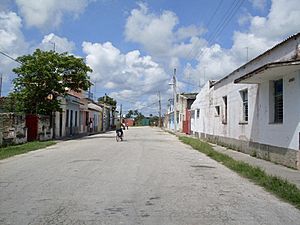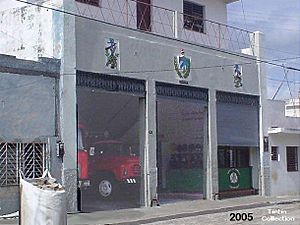Sagua La Grande facts for kids
Quick facts for kids
Sagua la Grande
|
||
|---|---|---|

View of a central town's road
|
||
|
||
| Nickname(s):
La Villa del Undoso
|
||

Sagua la Grande municipality (red) within
Villa Clara Province (yellow) and Cuba |
||
| Country | Cuba | |
| Province | Villa Clara | |
| Founded | 1812 | |
| Established | 1842 (Municipality) | |
| Area | ||
| • Municipality | 661 km2 (255 sq mi) | |
| Elevation | 15 m (49 ft) | |
| Population
(2022)
|
||
| • Municipality | 49,986 | |
| • Density | 75.62/km2 (195.86/sq mi) | |
| • Urban | 42,984 | |
| Time zone | UTC-5 (EST) | |
| Area code(s) | +53-422 | |
Sagua la Grande is a city located on the north coast of Villa Clara in central Cuba. It's often called La Villa del Undoso or just Sagua. The city sits along the Sagua la Grande River. Nearby, you can find the Mogotes de Jumagua, which are cool limestone cliffs. Many small islands, called cays, are located off its northern coast. People from Sagua are known as "sagüeros".
Contents
History of Sagua la Grande
Sagua la Grande was founded in 1812. It became an official municipality in 1842. In the early 1900s, the city and its port, Isabela de Sagua, were very important for trade. Today, Sagua's economy relies on industries like sugar, chemicals, and food. Raising cattle and fishing are also big parts of its economy.
Two important historians have helped keep Sagua's past alive. Antonio Miguel Alcover Beltrán recorded events from the 1800s by talking to people who lived through them. More recently, Pedro Suárez Rojo (also known as Tintín) has collected many items. His "Tintin Collection" includes newspapers, books, photos, and videos from the 1900s and early 2000s.
Geography and Location
Sagua la Grande is in the northwest part of its province. It is close to the Atlantic Coast. The city shares borders with other municipalities like Quemado de Güines and Encrucijada. It includes several villages, such as Isabela de Sagua, which is the largest village and a port town right on the coast.
Population and Demographics
In 2022, the municipality of Sagua la Grande had about 49,986 people living there. The total area of the municipality is about 661 square kilometers (255 square miles). This means there are about 85 people per square kilometer.
Exploring Sagua's Architecture
Sagua la Grande has wide streets and not much traffic, which gives it a peaceful feeling. Many of its older buildings are from the time when Cuba was a Spanish colony. One beautiful building is El Casino Español (The Spanish Casino), built in 1908. It used to be a popular meeting place.
Old Buildings and Styles
The way Sagua la Grande grew and its buildings changed shows its economic history. In 1830, just 18 years after it was founded, it was already a busy center with many sugar mills. This led to different types of houses being built. Some were made of wood and tile, while others used mud and straw.
By 1841, Sagua had 1,216 people living in 253 houses. Most buildings from this time were simple. They often had beautiful central courtyards, colorful stained glass, and large halls inside. One famous house was the Count More's house, built in the 1870s. He was important for starting the railway in the area.
In 1849, the city's streets were planned out. They became wide and straight, following the curves of the river. This was because the town grew around the timber and tobacco trade, which depended on the river for transport.
Modern Changes
In the early 1900s, Sagua continued to grow. Many new buildings were constructed, showing off different styles. These included homes with detailed grilles and decorations. Even with new technology, wood was still used for buildings like the Ladies Tennis Club and the Cinema Theater Enchantment.
Today, the historic center of Sagua has 66 blocks with over 1,000 properties. About 70% of these buildings have special architectural value. You can see three main styles: eclectic (mixing different styles), neoclassical (like ancient Greek and Roman buildings), and traditional Cuban architecture.
In the 1950s, more modern buildings appeared. After the Cuban Revolution in 1959, many schools, clinics, and hospitals were built. These new buildings were often outside the historic center. This helped to keep the older buildings in the city center preserved.
Architectural Highlights
Sagua la Grande is known for its beautiful old buildings. Some of the most famous ones include:
- The railway terminal
- The Catholic Church
- La Villa de París
- Palacio Arenas
- The Grand Hotel Sagua
- The Spanish Casino
- The home of the Count of Casa Moré
Because of its unique history and architecture, Sagua la Grande was declared a National Monument on December 6, 2011.
Tourism and Natural Beauty
Sagua la Grande is becoming a popular place for tourists. Many old buildings that were once hotels or businesses are now being restored. Visitors often come to see the city's history and culture.
The area around Sagua also has amazing natural places:
- Sagua River: You can travel by boat for over 30 kilometers (18 miles) from the city to the river's mouth in Isabela. Isabela is famous for its oysters and long history as a port.
- Mogotes de Jumagua: These are limestone hills, second in importance in Cuba. They are the last remaining natural forests in the area.
- Parador La Roca: This viewpoint on the southern Sierra de Jumagua mountains offers great views of the river plain.
- Alacranes Reservoir: This is Cuba's third-largest artificial lake.
- Northwest Cayería of Villa Clara: These small islands have unique sea stories, deep underwater caves like the Blue Hole, and beautiful, quiet beaches with white sand.
- Elguea Spa: This place is known around the world for its healing mineral waters.
In 2018, Sagua la Grande was officially launched as an international tourist spot. This led to many projects to restore old buildings and build new hotels. The goal is to make Sagua a major tourist destination in Cuba, thanks to its natural beauty, history, and culture.
Transportation Links
Sagua is crossed by the "Circuito Norte" (CN), a national highway that runs through the southern part of its municipality. The city and its villages like Isabela are also connected by a railway line that goes to Santa Clara and Cifuentes. There's also a branch line from Sagua to Corralillo.
Notable People from Sagua
Many famous people were born in Sagua la Grande, including:
- Mel Martinez, a former U.S. Senator
- Wifredo Lam, a famous painter
- Antonio Machín, a well-known singer
- Joaquín Albarrán, a doctor
- Concepcion Campa Huergo, a scientist who helped develop the meningitis B vaccine
- Rodrigo Prats, a music composer
- Conrado Marrero, a baseball player
- Peter Henry Emerson, a photographer
- Elizabeth Pérez, a Cuban-Venezuelan journalist
See also
 In Spanish: Sagua la Grande para niños
In Spanish: Sagua la Grande para niños





